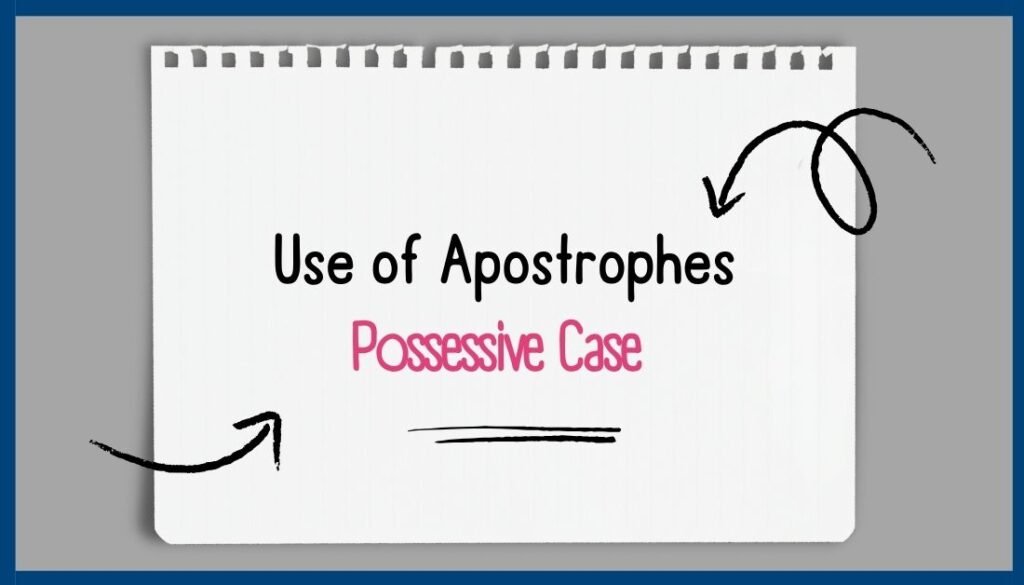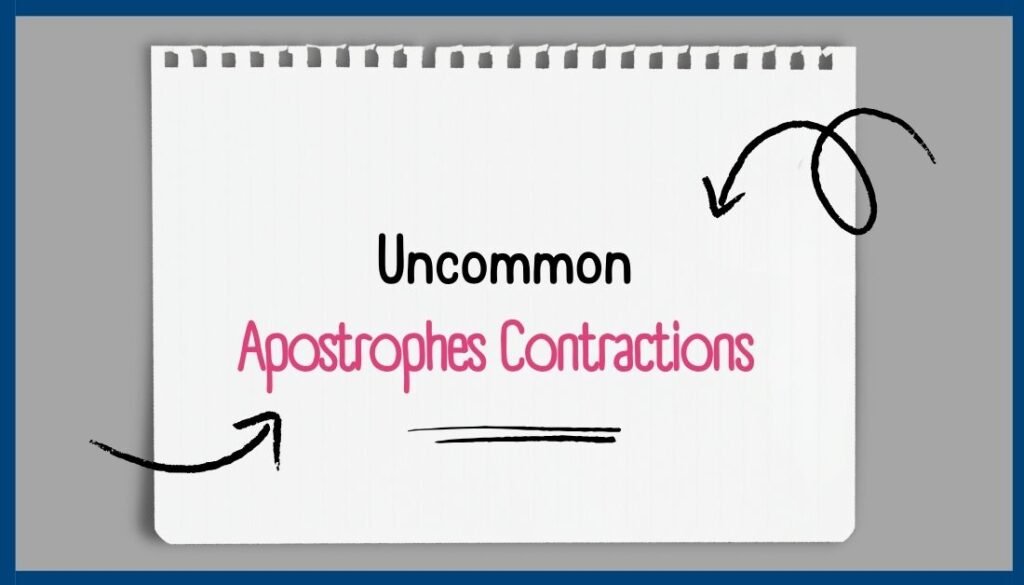How to Use Apostrophes Properly: English learners always really struggled with apostrophes, and when and when not to use them. Apostrophes follow loads of rules, and I see them misused all of the time. I know that sometimes I might misuse them as well, but I think today we should just clarify all of our doubts and use apostrophes properly once and for all.
I really do think this article will help anybody who needs to write frequently, anyone who’s going to take an English exam like the IELTS or the FCE, or even the CAE, anyone who needs to write emails frequently, even text messages if you want to use correct grammar throughout text messages, school essays, native speakers, and non-native speakers, whether they already speak English or you’re learning English. This amazing article is for absolutely everybody.
How to Use Apostrophes Properly
That being said, let’s get started with the punctuation lesson. So, how’s this lesson going to be structured? Well, first, I’m going to be talking about the possessive case, the genitive case where apostrophes show possession or a relationship between two things. I’m then going to show you how apostrophes are used in verb pronouns and some noun contractions. And then finally, I’ll show you some extra miscellaneous contractions using apostrophes as well. Let’s get started.
Use of Apostrophes in Possessive Case

So let’s talk about the possessive case. Normally, it uses the apostrophe ‘s’, but there are some exceptions. This shows possession, a relationship between two things, normally with one thing belonging to the other. For example:
- the ball of the dog” becomes “the dog’s ball.
1. Apostrophes rule for Singular Nouns
So, how do we use them with singular nouns? Well, we just add the apostrophe ‘s’. For example,
- Jonh’s car is orange
- I ate dinner at Will’s house.
2. Apostrophes rule for Singular Nouns
But what happens if those singular nouns end in ‘s’? Now, this is a little bit of a cause for dispute in the English grammar world, but the most accepted form is to add the apostrophe ‘s’ as well. For Example:
- ___ + ‘s (most accepted)
.Now, this is disputed, and some people will argue that we should just add the apostrophe. Such as:
- ___ + ‘ (less traditional)
Whatever you choose to do, make it consistent. Choose one of those rules and be consistent with it, so at least it looks like you know what you’re doing
I personally like to stick with the apostrophe ‘s’ [___ + ‘s] because I think it’s the most traditional. For example:
- The actress’s role was difficult
- Jess’s dog is called Mable.
Now, with the other rule where they just put the apostrophe and they don’t put the ‘s’, you will still treat it in spoken English as if you had that ‘s’ there. So you will still say:
- the actress’ role was difficult
- Jess’ dog is called Mable
Even though the ‘s’ is not there. It’s complicated. [How to Use Apostrophes Properly]
3. Apostrophes rule for Plural Nouns – S
So what about plural nouns? Well, regular plural nouns usually end in ‘s’, and for these, to show possession, you just need to add an apostrophe to the end of them. Such as:
- ___ + ‘
For example:
- my grandparents’ house is cozy
- my friends’ party was amazing.
Now, this is why English is a little bit difficult because if I say these two sentences:
- my friend’s party was amazing
- my friends’ party was amazing
The first one is just referring to one friend, and the second one is referring to two friends. The apostrophe has changed place, but it sounds the same in spoken English. That’s why you need to add a bit of context.
4. Apostrophes rule for Irregular Plural Nouns
But what about those plural nouns that don’t end in ‘s’? For example, “children.” Well, like the singular nouns, we just add the apostrophe ‘s’.
- ___ + ‘s
For example:
- the children’s clothing is to your left
- the women’s party is starting.
Now, these examples are less complicated because the plural and singular versions of those nouns sound different on their own. But if you had a noun like “sheep,” you have one sheep, two sheep. Well, it gets a bit more complicated because, as we explained in the last example, it sounds the same.
So we’ve cleared up where to use apostrophe and where to use apostrophe ‘s’. And the general consensus is, to add the apostrophe ‘s’ to everything apart from regular plural nouns that end in ‘s’, and for those, we just add the apostrophe.
One important thing to note is that sometimes that second noun isn’t necessary. You don’t have to repeat yourself. For example:
- my house is smaller than my parents’ house.
- my house is smaller than my parents’.
The meaning is clear. I’m not trying to say that my house is smaller in size than my parents are in size. I’m trying to say that my house is smaller than my parents’ house, which is bigger. The meaning is more or less clear, so we don’t have to repeat ourselves with that second house. [How to Use Apostrophes Properly]
Apostrophes rule for Nouns with Multiple answers
Now, what happens if one object has more than one owner? What if Ali and Jonh were to buy a cat together? Would it be:
- John’s and Ali’s cat
- John and Ali’s cat”?
Well, if we are both the owner, it would be:
- John and Ali‘s cat.
Because the last person in the list takes the possessive form.
However, if they are similar items that are owned individually, say John has a cat and Ali has a cat, it would be:
- John‘s and Ali‘s cats
Students also read: C1 Grammar: Quick Questions and Answers
Apostrophes in Verb Contractions

Now, let’s learn about apostrophes with verb contractions. I have five of the most common situations in which verb contractions are used with apostrophes.
So, an apostrophe in a verb contraction shows missing letters. For example:
- ‘I am’ = I‘m
That apostrophe is showing that missing ‘a’ and the space. It also gives you an indication of pronunciation.
1. Verb Contractions: Verbs + Not
- ‘do not’ = ‘don‘t’
- ‘cannot’ =s ‘can‘t’
- ‘could not’ = ‘couldn‘t’
- ‘should not’ = ‘shouldn‘t’
2. Verb Contractions: Pronouns + Not
The second example is pronouns and ‘will’. For example:
- ‘I will’ = ‘I‘ll’
- ‘she will’ = ‘she‘ll’
- ‘they will’ = ‘they‘ll’
3. Verb Contractions: Pronouns/nouns + to be
The third one, and this one can be slightly more complicated, is pronouns and nouns with ‘to be’. For example:
- ‘I am’ = ‘I’m
- ‘you are’ = ‘you’re
- ‘John is’ = ‘John’s
So, if you look at “John’s” on its own, it could be showing the possessive case or it could be showing a contraction of the verb ‘to be’.
- John’s watching television
- It is John’s television
One of them is “John” + to be’, and the other one shows that the television is the television of John. “It is John’s television.”
Important note:
One thing to note is with “who” — “who’s” with the apostrophe is “who is,” “who’s” +’to be’.
- Who is = Who’s (contr.) For example: Who’s there?
“Whose” spelled W-H-O-S-E is the possessive form.
- Whose = possessive. For example: Whose bag is this?
It’s very important to remember that, especially when you’re writing in exams. It’s an incredibly common mistake, especially among native speakers. I have absolutely made the mistake in the past, but I’m really going to try not to make the mistake in the future. [How to Use Apostrophes Properly]
4. Verb Contractions: Pronouns + to have
Number four is Pronouns + the verb ‘to have’.
- I have = I‘ve
- she has = she‘s (So, “she’s” could be “she is” or “she has).
You have to look at the context. Note though it would not be confused with the possessive because the possessive would be “hers.”
5. Apostrophes Verb Contractions: pronouns + would or had
The last one, number five, is pronouns plus ‘would’ or ‘had’. For example:
- I had = I‘d
Now, we would use this in situations like “I’d better go (I had better go)”.
- We wouldn’t say:
I’d a dog when I was 12 - We would say: I had a dog when I was 12
And then with “would”
- I would = I‘d
We do that in everyday conversation.
Other Apostrophes Contractions

Now, I’d just like to quickly cover three others that are not so common but still really important, and you will definitely come across them.
1 Apostrophes Contractions: Years
The first situation is when we talk about years, but we drop a couple of the numbers. For example:
- the summer of ’69
We know that we’re talking about 1969, but we might just want to say ’69’. It’s more common to use this when describing the 1900s.
2. Apostrophes Contractions: Drop ‘of’ or ‘the’
The next situation is where we drop the words “of”. For example:
- two o’clock
Originally, it was “of” or in the surname “Donovan”. It would have likely been “of Donovan” originally.
3. Apostrophes Contractions: Pronunciation
The last situation is to show pronunciation in dialogue. For example:
come on” could be changed to “c’mon'”. And we’d use an apostrophe in that to give guidance on how to pronounce it. “c’mon” is different to “come on”. Isn’t it, right, guys?
Conclusion
That is it for my grammar lesson on apostrophes. You learned throughout this article, ‘how apostrophes are used in sentences and how an aerophone changes sentence structure and pronunciation”. [How to Use Apostrophes Properly] These little things matter a lot if you are about to take an exam. There are many rules for using apostrophes, people tend to make mistakes. I hope I covered many of those rules in this article and I really hope you found it useful. I learned a great deal by putting it together.
Student also read: 73 Common English Grammar Mistakes and How to Avoid Them